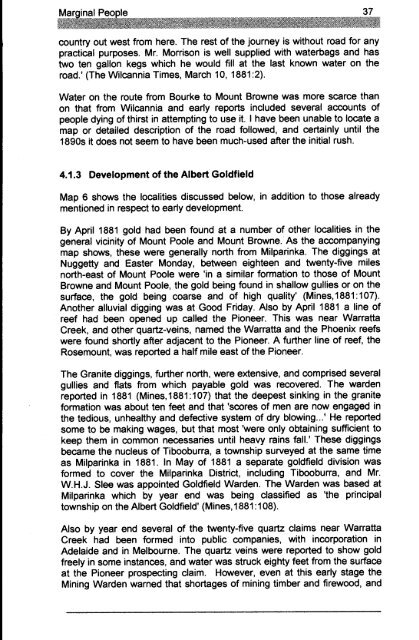Adec Preview Generated PDF File - The Sydney eScholarship ...
Adec Preview Generated PDF File - The Sydney eScholarship ...
Adec Preview Generated PDF File - The Sydney eScholarship ...
Create successful ePaper yourself
Turn your PDF publications into a flip-book with our unique Google optimized e-Paper software.
country out west from here. <strong>The</strong> rest of the journey is without road for any<br />
practical purposes. Mr. Morrison is well supplied with waterbags and has<br />
two ten gallon kegs which he would fill at the last known water on the<br />
road.' (<strong>The</strong> Wilcannia Times, March 10, 1881:2).<br />
Water on the route from Bourke to Mount Browne was more scarce than<br />
on that from Wilcannia and early reports included several accounts of<br />
people dying of thirst in attempting to use it. I have been unable to locate a<br />
map or detailed description of the road followed, and certainly until the<br />
1890s it does not seem to have been much-used after the initial rush.<br />
4.1.3 Development of the Albert Goldfield<br />
Map 6 shows the localities discussed below, in addition to those already<br />
mentioned in respect to early development.<br />
By April 1881 gold had been found at a number of other localities in the<br />
general vicinity of Mount Poole and Mount Browne.· As the accompanying<br />
map shows, these were generally north from Milparinka. <strong>The</strong> diggings at<br />
Nuggetty and Easter Monday, between eighteen and twenty-five miles<br />
north-east of Mount Poole were 'in a similar formation to those of Mount<br />
Browne and Mount Poole, the gold being found in shallow gullies or on the<br />
surface, the gold being coarse and of high quality' (Mines,1881:107).<br />
Another alluvial digging was at Good Friday. Also by April 1881 a line of<br />
reef had been opened up called the Pioneer. This was near Warratta<br />
Creek, and other quartz-veins, named the Warratta and the Phoenix reefs<br />
were found shortly after adjacent to the Pioneer. A further line of reef, the<br />
Rosemount, was reported a half mile east of the Pioneer.<br />
<strong>The</strong> Granite diggings, further north, were extensive, and comprised several<br />
gullies and flats from which payable gold was recovered. <strong>The</strong> warden<br />
reported in 1881 (Mines, 1881 :107) that the deepest sinking in the granite<br />
formation was about ten feet and that 'scores of men are now engaged in<br />
the tedious, unhealthy and defective system of dry blowing.. .' He reported<br />
some to be making wages, but that most 'were only obtaining sufficient to<br />
keep them in common necessaries until heavy rains fall.' <strong>The</strong>se diggings<br />
became the nucleus of Tibooburra, a township surveyed at the same time<br />
as Milparinka in 1881. In May of 1881 a separate goldfield division was<br />
formed to cover the Milparinka District, including Tibooburra, and Mr.<br />
W.H.J. Slee was appointed Goldfield Warden. <strong>The</strong> Warden was based at<br />
Milparinka which by year end was being classified as 'the principal<br />
township on the Albert Goldfield' (Mines,1881:108).<br />
Also by year end several of the twenty-five quartz claims near Warratta<br />
Creek had been formed into public companies, with incorporation in<br />
Adelaide and in Melbourne. <strong>The</strong> quartz veins were reported to show gold<br />
freely in some instances, and water was struck eighty feet from the surface<br />
at the Pioneer prospecting claim. However, even at this early stage the<br />
Mining Warden warned that shortages of mining timber and firewood, and




